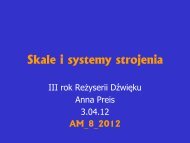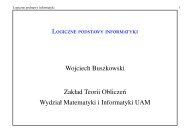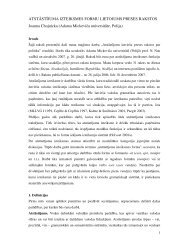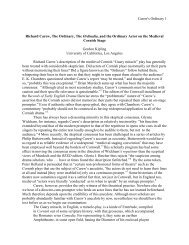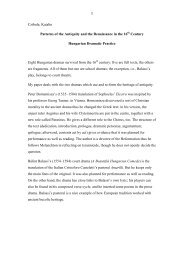Amir Weiner Getting to Know You
Amir Weiner Getting to Know You
Amir Weiner Getting to Know You
Create successful ePaper yourself
Turn your PDF publications into a flip-book with our unique Google optimized e-Paper software.
GETTING TO KNOW YOU 39<br />
of battleships (only one seemed <strong>to</strong> have been blackmailed in<strong>to</strong> informing<br />
based on objectionable social origin, and none of the rest was motivated by<br />
material concerns) offered detailed information on the job performance,<br />
private lives, and political past of their fellow workers. 108 In fall 1956, one<br />
could ask: what good did all this information yield?<br />
The KGB estimated that a crowd of 30,000–40,000 people gathered at<br />
the old Rasos his<strong>to</strong>rical cemetery in Kaunas on the night of 2 November<br />
1956. The All Souls’ Day tradition of lighting candles quickly turned in<strong>to</strong><br />
mass political demonstrations and violent clashes with the police, with<br />
support for Hungary and calls for an independent Lithuania, free of Russians.<br />
The urgent KGB investigation came up with the embarrassing discovery that<br />
most of the ringleaders of the mass disturbances were student members of<br />
the Komsomol, including many of working-class origins. 109 Caught offguard,<br />
the KGB offered a succinct ex post fac<strong>to</strong> analysis of a variety of causes<br />
for the eruptions, yet no one tried <strong>to</strong> explain how students were allowed <strong>to</strong><br />
agitate uninterrupted and <strong>to</strong> interact freely with foreign students. The poor<br />
state of surveillance was underlined by alarmed ethnic Russians in Kaunas,<br />
who appealed directly <strong>to</strong> Moscow, citing their lack of confidence in the local<br />
party and KGB, which they accused of misleading Moscow and intentionally<br />
downplaying the political significance of the riots. 110 By all accounts, this was<br />
a low moment in the illustrious life of Soviet surveillance. Still, how did it<br />
come <strong>to</strong> this?<br />
Explaining Methods, Measuring Success<br />
Why did the Soviets <strong>to</strong>lerate inaccurate information despite being aware<br />
of the problem? While such a dilema cannot be explained by a monocasual<br />
fac<strong>to</strong>r, one systemic feature emerged above all. Under Stalin, carpet bombing<br />
reigned over precision hits, and for good reason. Information gathering was<br />
shaped by an overarching principle that guided the entire system: working<br />
<strong>to</strong>ward the Vozhd´ (Leader). Much like their Nazi counterparts, Soviet<br />
practices were driven by an intentional lack of institutional integrity that<br />
allowed for interference at will by the supreme leadership. Encouraged and<br />
intimidated by a leader known for his uninhibited brutality, informed by a<br />
militant ideology, and operating in uncertainty and within a warlike ethos,<br />
anxious agencies and individuals did their best <strong>to</strong> outdo one another in an<br />
attempt <strong>to</strong> anticipate the will of the supreme leader or <strong>to</strong> please him, further<br />
108 ERAF SM f. 131, n. 1, s. 352, ll. 1–13.<br />
109 LYA f. K-1, ap. 3, b. 509, ll. 176–203, 242–51; b. 510, ll. 330–34.<br />
110 “Sotsial´no-politicheskaia obstanovka v Pribaltike v 50-e gody,” Voennye arkhivy Rossii, no.<br />
1 (1993): 250.



